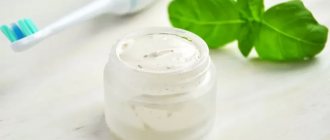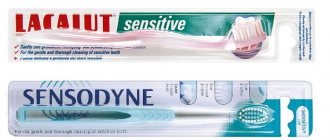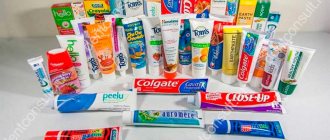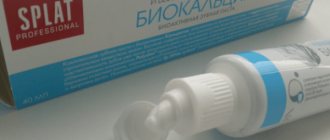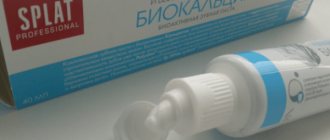- Types of toothpastes
- Properties of toothpastes
- Composition of toothpastes
- Choosing toothpaste according to problem
How many of us buy toothpaste? They make a shopping list and go to the hypermarket. If this sounds like you, then most likely you underestimate the role of toothpaste in your health. A good toothpaste protects against caries, ensures that teeth do not lose minerals, and most importantly, does not harm the enamel. In this article, we will analyze in detail the compositions of modern pastes and tell you how to choose the one that really suits you.
Why is calcium used in toothpaste?
The basis of bones and hard tooth tissues consists of calcium. He is responsible for their strength. During nutrition, an acidic environment is created in the oral cavity, which destroys calcium compounds. If the substance does not enter the body in the required quantity, over time, foci of demineralization appear, tooth enamel becomes thin and sensitive, and as a result, caries appears. Without proper care, hard tissues become fragile. Under mechanical loads, pieces may break off from them.
To avoid negative manifestations, use specialized personal hygiene products. They replenish the mineral composition of the enamel, eliminate hypersensitivity and protect the surface from caries. When used in a timely manner, drugs not only have a preventive effect, but also treat diseases in the initial stages.
The best toothpaste for caries: how to choose
It is worth saying that there is no separate class of “medicinal toothpastes for caries.” Almost 90% of products of this type contain fluoride. It is the main component that helps prevent the development of carious processes. However, the concentration of this substance in a particular toothpaste may vary.
Pastes with a fluorine content of about 1000 ppm have a moderate preventive effect. If this component is contained in a volume of 1450 ppm, the product can be classified as a therapeutic and prophylactic type. To treat teeth for the purpose of remineralization of enamel, pastes with a fluoride concentration of 5000 ppm are used. However, such compositions can only be used for their intended purpose.
The anti-caries effect is achieved if the toothpaste, in addition to fluoride, contains the following components:
- Calcium. If there is not enough of this substance in the enamel, it becomes more vulnerable to caries. Therapeutic paste with calcium helps restore the balance of minerals and prevent the development of the disease or stop it at the initial stage.
- Antiseptics (for example, chlorhexidine). They are not present in every toothpaste. Such compositions are recommended for people with irregular oral hygiene.
- Abrasives and hydrogen peroxide, which have a whitening effect and remove plaque from enamel. Therapeutic toothpastes with similar components can be harmful in case of advanced caries. In general, dentists recommend caution when using products with abrasive components. They are contraindicated for use in cases of increased tooth sensitivity and enamel abrasion.
- Natural components. Such pastes are suitable for sensitive gums and teeth in the cervical area (near the gums). A carious process can develop in this area of the jaw. If you treat your gums, reduce their sensitivity and eliminate bleeding, you can prevent tooth decay.
A good anti-caries paste should have a uniform structure and a pleasant smell. If it contains foreign grains or foreign components, it is better not to use it. It is also important that the paste is easily squeezed out of the tube and distributed evenly over the bristles of the toothbrush. If it is too thick or, on the contrary, liquid, then most likely it does not meet the quality requirements. After twisting the tube, the composition should not harden. If the cap sticks to the threads, the paste may contain some harmful or unknown components.
Now we’ll tell you which specific toothpastes are suitable for caries prevention.
Advantages of calcium over fluoride
To restore the mineral composition of enamel, fluoride or calcium is added to toothpastes. The first one has a number of disadvantages:
- Negatively affects health. When choosing fluorine-containing products, you need to pay great attention to the dosage of the active component. An excess can lead to the appearance of fluorosis on the surface of the teeth and a general disruption of the bone structure. That is why the dosage is always indicated on the packaging, which is selected depending on the person’s age and the condition of the enamel.
- Not allowed with fluoridated tap water. In this case, toothpaste containing fluoride leads to an excess of the mineral in the body and causes disease. But this does not mean that you are getting enough minerals from the water. Therefore, they need to be restored in other ways.
Calcium-containing preparations do not have such disadvantages. They are safe and suitable for regular daily use.
Types of toothpastes
But first, let's discuss the types of pastes. According to GOST 7983-99, all toothpastes are divided into hygienic and therapeutic and prophylactic.
Hygienic pastes are designed for mechanical removal of food debris and plaque from enamel. They contain no drugs.
Therapeutic and prophylactic pastes are intended for the prevention of various oral diseases: caries, gingivitis, periodontal disease. Such pastes have antiseptic and anti-inflammatory effects. Most of them are suitable for daily cleaning.
It would be rational to add another category - medicinal. They must be used strictly in courses - for example, after surgical interventions and other medical procedures. And also for severe dental problems.
Rospotrebnadzor has a different classification of pastes - by purpose. The organization identifies four types of toothpastes with proven effectiveness:
- fluoride-containing (reduce the risk of developing caries and demineralization of enamel);
- with triclosan (have an anti-inflammatory effect in gum diseases);
- whitening agents (help in the fight against dark plaque);
- desensitizing (reduce the increased sensitivity of teeth to sour, hot and cold).
Indications for the use of toothpastes with calcium
Specialized products have medicinal properties. Dentists recommend using it when the following diseases occur:
- demineralization of enamel;
- increased sensitivity;
- low resistance of teeth to acid attack;
- caries at the white spot stage;
- chips and scratches on the surface of the teeth;
- tendency to form tartar.
Calcium-containing products are used not only for treatment, but also for the prevention of diseases. If our diet is perfectly balanced, the body receives the required amount of minerals and trace elements. In this case, there is no need to use additional drugs. But few people can boast of a balanced diet. Periodic use of calcium-containing hygiene products helps to avoid negative manifestations.
Choosing toothpaste according to problem
When choosing a toothpaste, base it on your current dental situation or problem that is bothering you. Use different pastes in the morning and evening. For example, in the morning - whitening, in the evening - restoring enamel. Change pastes over time - you shouldn’t use the same favorite one all your life.
Raid
Even with healthy teeth and gums, you need to remember about prevention. Daily high-quality cleaning of plaque helps to avoid many problems - unpleasant odor, tartar, caries and gum inflammation.
Strike after strike - discord. Everyone has a mild bacterial plaque, and any good paste should cope with it. But there is a tendency to increased plaque formation or persistent pigmentation due to smoking, coffee, red wine and other coloring products. And this already requires special hygiene products.
It is important to remember here: if plaque is not removed well, it will turn into tartar. You can deal with plaque on your own, but you can deal with tartar only in the dentist’s office.
Choose pastes for daily use with an abrasiveness of no higher than 80 and a fluorine or hydroxyapatite content of at least 950 ppm. Complete your care with an irrigator and mouth rinse.
Unpleasant smell
Bad breath (or halitosis) causes self-doubt for many people. A slight odor from the mouth in the morning is normal. A sharp unpleasant odor that persists throughout the day indicates the presence of some kind of pathology.
The cause of halitosis is the formation of volatile sulfur compounds in the mouth, which are released by bacteria. This happens due to poor hygiene, caries, gum inflammation, and smoking. Halitosis can also be associated with diseases of the gastrointestinal tract, respiratory system and kidneys, diabetes mellitus, taking medications, etc. If serious causes of halitosis are excluded, you can cope with it on your own.
Many manufacturers say that their pastes eliminate bad breath. In reality, they simply disguise it for a while.
Choose antibacterial paste. The composition must contain active components that eliminate volatile sulfur compounds. First of all, it is zinc. Only then will the paste not mask, but actually solve the problem. The composition may also include eucalyptus and thymol oils and charcoal. It is worth supplementing the care with a mouthwash containing the same ingredients.
Sensitive enamel
The problem of enamel sensitivity requires careful and gentle cleaning - any strong impact can cause pain and make it worse. If your teeth react to hot, cold, or sharp things, low-abrasive pastes with an RDA of no higher than 30 are suitable for you. For particularly sensitive enamel, choose pastes with hydroxyapatite, fluorine or calcium in the composition. They will strengthen the enamel, reduce its sensitivity and prevent the problem from reoccurring.
Sensitive gums
Irregular and poor oral hygiene is one of the main causes of inflammation and bleeding gums. An integrated approach is needed here.
Choose pastes containing chlorhexidine, plant extracts (oak bark, sage, chamomile, etc.), allantoin, essential oils (menthol, thymol). To pair with the paste, choose a brush with soft bristles. And don't forget to change it every 3 months. Complete your care with a rinse for sensitive gums.
In the later stages of periodontal disease, pastes with more powerful antiseptics are used: triclosan, chlorine dioxide, zinc. They help remove unpleasant odor, protect gums from inflammation and slow down the accumulation of bacteria. What they all have in common is that they destroy not only pathogenic microorganisms, but also, over time, beneficial microflora. Such pastes can be used in courses of no more than 2-3 weeks, in rare cases - up to 1 month. Otherwise, they can cause oral dysbiosis.
Color change
The reasons for darkening of the enamel can be very different - poor cleaning, smoking, frequent consumption of coffee, tea, red wine. For darkened teeth, a toothpaste with a whitening effect is suitable. If you want to restore natural whiteness or prolong the effect of professional whitening, choose pastes containing papain, bromelain, and carbamide peroxide.
Plaque from coloring products should be removed with abrasive pastes, and the dentin under the enamel should be lightened with the help of peroxides. Thus, carbamide peroxide is the most effective whitening component. And if the paste contains various strengthening and restoring substances, you get not only a whitening effect, but also comprehensive care.
Prevention of caries
Caries is the most common disease in the world. This is a pathological process of destruction of hard tooth tissues. It begins with a white spot and ends with pulpitis and various septic processes with inevitable tooth loss.
The main cause of caries is bacteria that produce acids. They wash fluoride and calcium out of the tooth tissue and weaken it. Frequent consumption of sweets accelerates the development of carious bacteria: carbohydrates are a favorite environment for their reproduction. Teeth with thinned enamel are also at risk: through microcracks, bacteria penetrate into the dentinal tubules and begin to destroy the tooth from the inside.
The most important stage in effectively combating caries is early diagnosis of the problem and, of course, prevention. Remove plaque at least once every 12 hours. Use pastes that contain sodium monofluorophosphate, sodium fluoride, amino fluorides, calcium glycerophosphate, xylitol. They strengthen enamel, fill microcracks and can even cure caries at the white spot stage. Supplement your care by using an irrigator to clean the interdental spaces - the place where a brush fails and where caries most often begins.
Prevention of caries is especially important during pregnancy, when the body actively spends a huge amount of calcium. Therefore, you need to select a remineralizing, anti-caries paste. It should not contain SLS, parabens, synthetic dyes, or a high RDA index.
Rating of toothpastes with calcium for adults
When choosing a hygiene product, it is not enough to make sure that it contains calcium-containing components. A positive effect can only be achieved if they are well absorbed by the body. The following compounds have proven themselves to be excellent in practice:
- pantothenate;
- citrate;
- lactate;
- glycerophosphate.
Sometimes, to give the recipe universal properties, manufacturers add fluorine and calcium at the same time. These components do not fit well together and cannot demonstrate the desired result.
PresiDENT Unique
The hygiene product is designed specifically for use in regions with high fluoride content in water. The active ingredients replenish the lack of minerals in hard tissues and effectively restore them. With regular use, increased sensitivity disappears.
The cleaning agents have a controlled abrasiveness of 75 RDA. This is enough to effectively remove daily plaque. Negative manifestations disappear, and the smile acquires a natural whiteness.
ROCS "Active calcium"
The toothpaste has a low level of abrasiveness. This allows it to be used for the hygiene of weakened teeth with increased sensitivity. At the same time, you do not experience pain.
The active action is based on xylitol. It is a natural component that effectively restores hard tissue. During cleaning, the product neutralizes the acidic environment, which reduces the risk of caries.
Cedar balm “With calcium”
The product does an excellent job of eliminating painful sensations. A complex of cedar oil and lavender has an antiseptic effect. It heals wounds and restores damaged periodontal areas. Lavender imparts bactericidal properties. It prevents the development of pathogenic microorganisms and eliminates bad breath.
Calcium glycerophosphate is used to maintain enamel health. It strengthens sensitive teeth and protects them from caries.
President Unique
To prevent problems from occurring, you need to regularly perform professional oral and dental hygiene in a clinical setting. This is the only way to avoid gingivitis, stomatitis, periodontitis, caries, and damage to the enamel layer. After such procedures, dentists recommend that patients use hygiene products that restore and strengthen the enamel. President Unique is a product of an Italian manufacturer. In addition to papain and hydroxyapatite, it contains aloe extract, as well as vitamin E and spherulites extracted from the juice of Acacia Senegalese. These components gently and carefully clean and brighten the enamel layer of the units. Pros:
- Rapid regeneration of pathological enamel;
- Relieving inflammation, fighting bacteria;
- Prevents the accumulation of dirty plaque and hard stones;
- Beneficial effect on gum tissue;
- Improving blood circulation in the soft tissues of the oral cavity;
The product is successfully used for the treatment and prevention of the initial phase of periodontal disease.
Rating of toothpastes with calcium for children
Dentists do not recommend using calcium-containing products to clean baby teeth. But high levels of fluoride also have a negative impact on health. Therefore, the drugs should be used by adolescents. For children only if there are obvious problems with their teeth.
ROCS kids
Hygienic products have a low abrasiveness. This makes it possible to carefully but effectively care for children's enamel. Calcium glycerophosphate with xylitol strengthens it and prevents the appearance of caries.
Thanks to the presence of linden and chamomile extracts, it is possible to restore periodontal tissue. The composition reduces bleeding and pain, reduces the risk of the appearance and development of gum disease.
Splat Baby
The active formula of the toothpaste includes dicalcium phosphate dihydrate. It destroys plaque with daily cleaning and restores the surface after mechanical impact. The LUCTATOL complex, based on licorice extract, has a special effect. It creates a protective layer on the teeth that prevents the deposition of dirt and the development of diseases.
The effectiveness of the products has been tested in extensive clinical trials. The composition is suitable for children's teeth from birth to three years.
SILCA Putzi
The hygiene product is designed for children from 2 to 12 years old. It has a pleasant taste that makes it appealing to kids. They do not experience negative emotions during the cleaning process and willingly switch to independent hygiene. Moreover, only natural substances are used in the recipe. They are safe even if swallowed.
Low abrasive particles do an excellent job of removing dirt. Calcium-containing substances restore the mineral structure. Vitamin E nourishes the gums.
Fluorine-containing components
There are several of them: tin fluoride, amino fluoride, sodium monofluorophosphate, sodium fluoride. The latter is most common as an additive in toothpastes. Numerous studies and practical experience over several decades have proven the effectiveness of this compound in preventing caries and maintaining enamel resistance to acids. However, in recent years there has been a split in the scientific community regarding the advisability of using such pastes. The fact is that fluorine compounds in high concentrations are very toxic, which is fraught with abnormal bone mineralization, kidney failure, liver inflammation, impaired secretion of insulin and thyroid hormones, and general poisoning. It is impossible to get such doses by simply brushing your teeth, but opponents of fluoride-containing products appeal to the fact that in some regions people receive fluoride from other sources (mainly from water) and it can accumulate in the body. In general, the benefits of using fluoride-containing pastes do not outweigh the potential harm to the body, so they should be used with caution and for a short time without a doctor’s prescription.
Reliable shield. Which toothpaste should you choose for children? More details
Rating of toothpastes with biocalcium
Biocalcium particles are synthesized substances based on natural hydroxyapatite. It completely replicates the mineral structure of enamel, so it copes better than others with the task of restoring damaged tooth surfaces.
DIES "Biocalcium"
Designed for gentle professional whitening and strengthening of enamel. Does an excellent job of cleaning due to the presence of enzymes and abrasives. Papain penetrates deeply into the plaque structure and breaks it down from the inside. After this, abrasive substances remove all dirt. Hydroxyapatite strengthens the surface damaged during cleaning.
The fish oil present in the recipe promotes the rapid absorption of calcium-containing elements.
Splat "Biocalcium"
The active formula of the toothpaste includes calcis, which is obtained from eggshells. In combination with hydroxyapatite, it becomes a building material that can strengthen the natural structure of the tooth. Thanks to the increased concentration of components, it is possible to quickly reduce enamel hypersensitivity.
The product has excellent hygienic properties. Papain softens even hardened plaque deposits. Soft abrasives gently remove them from the surface.
The most modern and effective calcium compounds in fluoride-free toothpastes:
Of the compounds listed below, the palm can be given to two components: 1) synthetic medical nano-hydroxyapatite (nHAP), but subject to its correct concentration and correct particle size, 2) amorphous calcium phosphate associated with casein phosphopeptides (CPP-ACP). However, we will describe other compounds such as tricalcium phosphate (TCP) as well as Novamin®.
Medical nano-hydroxyapatite (nHAP) –
Hydroxyapatite (synonym: calcium phosphate hydroxide) is a stable and biocompatible calcium phosphate with low solubility, which is used in dentistry to remineralize teeth, reduce their sensitivity, and also for teeth whitening. It is almost exactly the substance that makes up tooth enamel. Medical nano-hydroxyapatite (nHAP) was developed in 1970 by the American agency NASA for astronauts to replenish the amount of minerals in their teeth and bones lost in conditions of weightlessness.
The first commercial toothpaste based on nHAP was developed in 1978 by the Japanese. Currently, the company's Apagard® and Apadent® toothpastes contain nano-mHAP ® (a patented form of nano-hydroxyapatite with a particle size of 8 to 40 nanometers). Now many similar products with hydroxyapatite have appeared in the world and in Russia, but as you will see below, most of them do not have a very good composition and low efficiency.
The effectiveness of hydroxyapatite paste is affected by:
- Hydroxyapatite particle size – hydroxyapatite in toothpastes comes in 2 varieties. The best option is nano-hydroxyapatite (nHAP), whose particles are up to 100 nanometers in size. But most often, toothpaste contains the most common hydroxyapatite (HAP), the particles of which are only micro-sized - up to 5-10 microns in diameter. However, the granulometric composition shows that only particles with a diameter of up to approximately 1-3 microns demonstrate reliable adhesion to the enamel surface, which cannot be said about larger hydroxyapatite particles (source).
Thus, the smaller the particle size, the easier they adhere to the surface of the enamel, the more significant a protective layer they will form on its surface, the more effective the remineralization of teeth will be, the higher the protection against caries will be, the faster tooth sensitivity will disappear, and also, the lower the rate of plaque formation will be. Thus, the particle size of hydroxyapatite is one of the most important criteria for its effectiveness in toothpaste (or mouthwash).nHAP particles up to 50 nanometers will penetrate as deeply as possible into demineralized areas of enamel, as well as micro-cracks - as if filling them. The fact is that tooth enamel consists of so-called enamel prisms (the distance between which is 50 nanometers), as well as interprismatic substance. When enamel demineralizes, it is the interprismatic substance that dissolves first of all, which is physiologically less mineralized. Therefore, nHAP particles up to 50 nanometers are able to penetrate deeply into areas of demineralization.
Microscopy of tooth enamel –
According to the scientific work “Evaluation of the effectiveness of long-term use of Apadent Total Care toothpaste containing medical nano-hydroxyapatite” (authors Makeeva, Polyakova, etc.), the use of paste with nano-hydroxyapatite particles from 8 to 40 nm led to complete remineralization of artificially created foci of dental demineralization enamel – in just 1-3 days. Such small particles are able to immediately penetrate deep into the enamel - even at the earliest stages of development of foci of demineralization.
Important: scientific work confirms that toothpastes with nano-hydroxyapatite particles of any size (even larger ones from 50 to 100 nanometers) have more significant remineralizing and anti-caries effects than toothpastes with non-nano-sized hydroxyapatite particles. This is due to the fact that hydroxyapatite nanoparticles have a higher degree of hydrophilicity and adhere to the enamel surface much more easily than micro-sized hydroxyapatite particles. Consequently, nano-hydroxyapatite will form a layer on the surface of the enamel, which will adhere more firmly to the tooth structure (24stoma.ru).
- Concentration of hydroxyapatite in toothpaste - scientific studies demonstrate that the effectiveness of hydroxyapatite has a clearly defined dependence on its concentration in the composition of the product (source). Experimental data show that increasing the concentration of hydroxyapatite from 1 to 10% led to an increase in the coverage area of the enamel surface from 10 to 32%. Thus, when using products with 1% hydroxyapatite, only 9.6% of the enamel was covered with a layer of hydroxyapatite; when using 5% hydroxyapatite – 13.4% of the enamel surface; when using 10% hydroxyapatite - 32% of the enamel surface area (see figure below).
Please note that these figures were obtained using micro -particles of hydroxyapatite, and not nano-particles. The scientific work mentioned above also discusses the fact that the smaller the hydroxyapatite particles, the better they will adhere to the enamel surface. Thus, if we use nano -hydroxyapatite, it will form a protective layer over a much larger area of the tooth surface (and the thickness of this layer will be greater) - than when using the same concentration of hydroxyapatite microparticles.
But let's move from numbers to real clinical effectiveness, and try to measure it. Scientific research will help us with this, allowing us to compare the effectiveness of tooth remineralization when using toothpastes with different compositions. The scientific study “Comparative effectiveness of hydroxyapatite and fluoride toothpaste for the prevention and remineralization of caries in children” (authors Bennett T. Amaechi, et al.) - shows the clinical effectiveness of 10% nano-hydroxyapatite at the level of fluoride toothpaste containing 500 ppm amino fluoride. Elmex fluoride children's toothpaste was used for comparison.
Other studies, such as King et al. (2006) - it was found that 10% nano-hydroxyapatite has only a slightly less remineralizing effect than toothpaste with 900 ppm sodium fluoride. We will take the average between these two studies as a basis, and will assume that 1400-1450 ppm of fluoride in toothpaste for adults is considered the standard for anti-caries protection. Thus, it turns out that the effective concentration of nano-hydroxyapatite should be at least 15-20% (with nHAP particle size from 50 to 100 nanometers). But for toothpastes with even smaller nHAP particles up to 50 nanometers, 2 times lower concentrations will be effective.
Important: our editors do not consider it possible to trust Russian toothpastes where the manufacturer simply states: “contains hydroxyapatite”, “contains nano-hydroxyapatite”, “contains hydroxyapatite particles of different sizes” - where neither the concentration nor the size of the particles are indicated at all. After all, if toothpaste contains ordinary hydroxyapatite (with a particle size of more than 1-3 microns, which do not stick to the enamel surface at all), then these particles can only serve as an abrasive. The correct concentration and particle size of hydroxyapatite are competitive advantages that set the product apart from the rest. And if the manufacturer refuses on principle to disclose this information, we draw quite logical conclusions. Therefore, it is best to buy those toothpastes where the manufacturer has clearly indicated that it uses nano-hydroxyapatite, as well as its concentration.
Tricalcium phosphate (TCP) –
Tricalcium phosphate (TCP) is indeed used in a number of fluoride-free toothpastes, but it is also much less effective than nHAP or CPP-ACP toothpastes. Therefore, it is better not to use toothpastes that contain only TCP, but you can use those that contain TCP in combination with hydroxyapatite (for example, Korean toothpaste Dr.EL Shirin Care).
Toothpastes containing tricalcium phosphate in combination with fluorides will have an even higher effect of remineralizing teeth. An example of such a paste is “ CLINPRO tooth cream ”, which contains tricalcium phosphate + 900 ppm sodium fluoride (produced by one of the most famous manufacturers of dental materials in the world - American).
NovaMin® (calcium and sodium phosphosilicate) –
NovaMin® is nothing more than “calcium sodium phosphosilicate”, which is used in toothpastes usually in a concentration of 5%. To put it in simple language, this is synthetic bioactive glass. When toothpaste comes into contact with saliva, calcium phosphate is deposited on the surface of the tooth enamel, which will gradually transform into hydroxyapatite crystals. But it must be said that calcium and sodium phosphosilicate is certainly less effective - in comparison with toothpastes based on nHAP or CPP-ACP.
The scientific study “In Situ Study to Confirm the Anticaries Potential of a Sodium Monofluorophosphate Dentifrice Containing Calcium Sodium Phosphosilicate” (authors Parkinson C., Siddiqi M.) suggests that adding calcium and sodium phosphosilicate to fluoride toothpastes did not increase and did not reduce the remineralizing potential of these toothpastes. Those. when adding 5% calcium and sodium phosphosilicate to the toothpaste with 1450 ppm fluoride, its effectiveness remained at the same level as if the toothpaste contained only 1450 ppm fluoride.
Recaldent™ (CPP–ACP) –
One of the best components for mineralization/remineralization of teeth, as well as reducing the risk of caries, is “Amorphous calcium phosphate bound to casein phosphopeptides” (CPP-ACP). This component is patented under the name Recaldent™, and its effectiveness is not inferior to toothpastes with nano-hydroxyapatite (nHAP). The only point is that products with CPP-ACP are usually produced only for applications on teeth, and not for brushing teeth. This is due to the fact that there are a number of studies showing that abrasives in toothpastes significantly reduce the deposition of amorphous calcium phosphate on the surface of tooth enamel.
An example of a product is fluoride-free dental gel “ GC Tooth Mousse ” (made in the USA). This drug contains the CPP-ACP complex as well as xylitol. The drug is used 1-2 times a day for applications on the teeth for 3-5 minutes (in adults and children over 3 years old). There is also an even more effective version of this product - the GC MI Paste Plus , but it already contains a combination of CPP-ACP and 900 ppm sodium fluoride. It should also be taken into account that products with the CPP-ACP complex can cause allergies in patients with milk protein intolerance, because Casein phosphopeptides are produced from cow's milk.


